
The Agaricales are an order of fungi in the division Basidiomycota. As originally conceived, the order contained all the agarics, but subsequent research has shown that not all agarics are closely related and some belong in other orders, such as the Russulales and Boletales. Conversely, DNA research has also shown that many non-agarics, including some of the clavarioid fungi and gasteroid fungi belong within the Agaricales. The order has 46 extant families, more than 400 genera, and over 25,000 described species, along with six extinct genera known only from the fossil record. Species in the Agaricales range from the familiar Agaricus bisporus and the deadly Amanita virosa to the coral-like Clavaria zollingeri and bracket-like Fistulina hepatica.
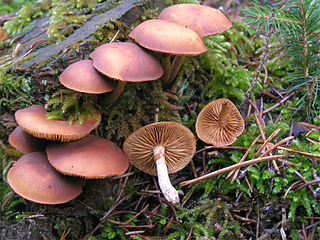
Galerina is a genus of small brown-spore saprobic fungi, with over 300 species found throughout the world from the far north to remote Macquarie Island in the Southern Ocean. The genus is most noted for some extremely poisonous species which are occasionally confused with hallucinogenic species of Psilocybe. Species are typically small and hygrophanous, with a slender and brittle stem. They are often found growing on wood, and when on the ground have a preference for mossy habitats.

The Tricholomataceae are a large family of fungi within the order Agaricales. Originally a classic "wastebasket taxon", the family included any white-, yellow-, or pink-spored genera in the Agaricales not already classified as belonging to e.g. the Amanitaceae, Lepiotaceae, Hygrophoraceae, Pluteaceae, or Entolomataceae.

The Agaricomycetes are a class of fungi in the division Basidiomycota. The taxon is roughly identical to that defined for the Homobasidiomycetes by Hibbett & Thorn, with the inclusion of Auriculariales and Sebacinales. It includes not only mushroom-forming fungi, but also most species placed in the deprecated taxa Gasteromycetes and Homobasidiomycetes. Within the subdivision Agaricomycotina, which already excludes the smut and rust fungi, the Agaricomycetes can be further defined by the exclusion of the classes Tremellomycetes and Dacrymycetes, which are generally considered to be jelly fungi. However, a few former "jelly fungi", such as Auricularia, are classified in the Agaricomycetes. According to a 2008 estimate, Agaricomycetes include 17 orders, 100 families, 1147 genera, and about 21000 species. Modern molecular phylogenetic analyses have been since used to help define several new orders in the Agaricomycetes: Amylocorticiales, Jaapiales, Stereopsidales, and Lepidostromatales.

Melanoleuca is a poorly known genus of saprotrophic mushrooms traditionally classified in the family Tricholomataceae. Most are small to medium sized, white, brown, ocher or gray with a cylindrical to subcylindrical stipe and white to pale yellowish gills. The basidiospores are ellipsoid and ornamented with amyloid warts. Melanoleuca is considered a difficult group to study due to their macroscopic similarities among species and the need of a thorough microscopic analysis to separate species. DNA studies have determined that this genus is closely related to Amanita and Pluteus and that it does not belong to the family Tricholomataceae.

The Inocybaceae are a family of fungi in the order Agaricales, the largest order of mushroom-forming fungi. It is one of the larger families within Agaricales. This family exhibits an ectomycorrhizal ecology. Members of this family have a widespread distribution in tropical and temperate areas.
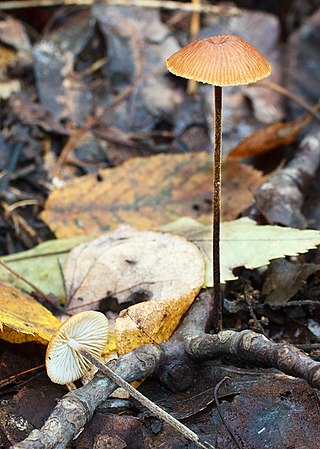
Rhizomarasmius is a genus of fungi in the family Physalacriaceae, containing about five species.

Callistosporium is a genus of fungi in the order Agaricales. Basidiocarps are agarics, either with a central stipe (stalk) or pleurotoid. The latter group were formerly referred to Pleurocollybia. Recent molecular research, based on cladistic analysis of DNA sequences, has shown that the genus is a natural, monophyletic grouping, though not all species have yet been sequenced. Species are saprotrophic, typically growing on wood, and the genus is found worldwide.

Macrocybe is a genus of fungi in the family Callistosporiaceae. Basidiocarps are agarics and were previously referred to Tricholoma, but are all large, whitish, and saprotrophic. Recent molecular research, based on cladistic analysis of DNA sequences, has shown that the genus is a natural, monophyletic grouping, though the status of several species is uncertain. Macrocybe species have a tropical to subtropical distribution.

Catathelasma imperiale, also known as Catathelasma imperialis, and commonly known as the imperial mushroom, Hutsul mushroom, or korban, is a species of agaric in the family Biannulariaceae. Basidiocarps are stocky, with a double annulus (ring), and a tapering to rooting stipe (stem). The species is ectomycorrhizal with conifers and is found in continental Europe and Asia. Reports from North America are unconfirmed and may refer to Catathelasma evanescens or similar species. Fruit bodies are edible and collected for food in China and elsewhere. The species is widespread but uncommon and is assessed as globally "near threatened" on the IUCN Red List of Threatened Species.
Sagaranella is a mushroom genus in the family Lyophyllaceae that has been segregated from both Lyophyllum and Tephrocybe using molecular analyses. The species resemble grey colored Collybias and grow in nitrogen-rich environments.
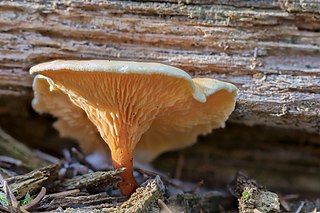
Bonomyces is a genus of fungi in the family Biannulariaceae. Basidiocarps are agaricoid, similar to those of Clitocybe, but with a distinctly hard stipe (stem). The genus is separated on DNA characteristics as well as morphology. Species are known from Europe, North Africa, and northern China.
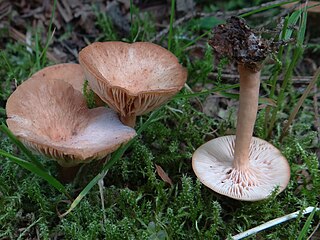
Bonomyces sinopicus is an agaricoid species of fungus in the family Biannulariaceae with a European districution. It has been given the recommended English name of spring funnel. The species was formerly placed in the genus Clitocybe, but has been separated on DNA characteristics.

Myrmecopterula is a genus of fungi in the family Pterulaceae. Basidiocarps are clavarioid and are associated with ant domestication by members of the genus Apterostigma.

Myrmecopterula moniliformis is a species of fungus in the family Pterulaceae and is the type species of the genus Myrmecopterula. It is associated with fungi cultivating ants of the genus Apterostigma.
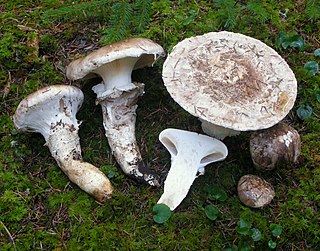
The Biannulariaceae are a family of fungi in the order Agaricales. The family contains three genera. All species form agaricoid basidiocarps. The family was originally described to accommodate the single genus Catathelasma, but has been extended as a result of DNA research.

The Callistosporiaceae are a family of fungi in the order Agaricales. The family contains six genera. All species form agaricoid basidiocarps. The family is based on recent DNA research.














